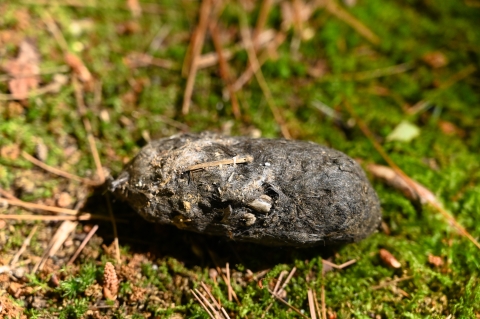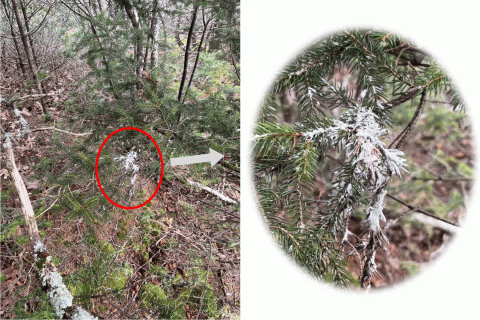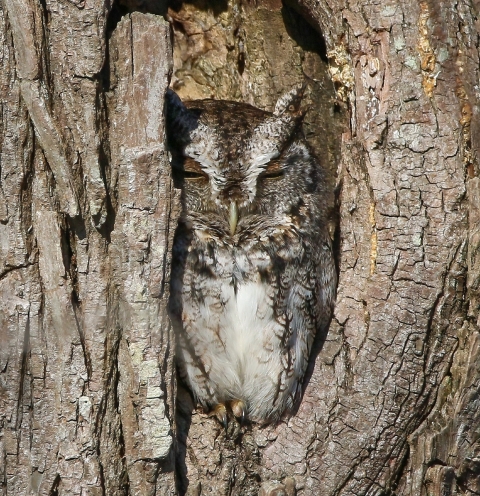Few people have laid eyes on the northern bog lemming, an elusive rodent that makes its home in remote bogs in northern spruce-fir forests.
But some owls probably have.
These birds of prey hunt a variety of animals, including small birds, amphibians, and rodents that elude human detection. Chances are owls whose habitat overlaps with that of the northern bog lemming — like barred and great-horned— have enjoyed this rare delicacy from time to time.
That possibility gave biologists who study the northern bog lemming an idea.
Regurgitated treasure
Owls leave intact traces of their meals behind. They swallow their prey whole and later regurgitate indigestible materials, such as bones and fur, in the form of pellets anywhere from an inch to several inches long, depending on the species.
Could owl pellets help biologists find the rare northern bog lemming? Maybe. If nothing else, they can expand what we know about the makeup and distribution of the small mammal community owls prey on.
That’s why partners in Maine are asking the public to be on the lookout for owls’ leftovers.
A collaboration of the U.S. Fish and Wildlife Service, the University of New England, and the Maine Department of Inland Fisheries and Wildlife, the Maine Owl Pellet Project is a community-science initiative that’s crowdsourcing clues left on the forest floor.
The project team will use genetic testing and visual identification to look for evidence of small mammals, including the northern bog lemming, in the submitted pellets.
Small bundles of hope
Finding traces of this rare species in new places would expand what scientists know about its distribution and habitat, informing work to conserve it.
The stakes are high: the northern bog lemming is listed as threatened by the state of Maine and has been petitioned for listing under the federal Endangered Species Act. Climate change adds to the urgency because of the potential to make the cool, wet habitat it depends upon warmer and dryer.
Although the chances of finding evidence of a northern bogging lemming are slim given the species’ narrow habitat niche, each pellet represents a small bundle of hope.
Visual cues and clues
Ready to join the search party?
Those who have hiked in Maine’s mountainous regions and remote forests may have come across owl pellets without realizing it.
“Probably the most prominent sign that you are near an owl pellet is what the birding community calls ‘whitewash,’” explained Zachary Olson, Ph.D., associate professor of animal behavior within the University of New England’s School of Social and Behavioral Sciences and one of the project leads.
Olson explained that over time, as owls roost in trees, their excrement can leave white streaks on the tree, ground or nearby vegetation.
“This whitewash can be a visual cue that you’ve found an owl roost, and finding a roost narrows your search and increases your chances of spotting owl pellets,” he said.
He advises sleuths to keep their eyes on the forest floor for pellets 1 to 3 inches long, oblong in shape, that look like hair and bones pressed together.
“Any pellet you find would be a huge help to the project,” Olson said.
If you do find a pellet, simply note your location, place it in a plastic, zip-top bag, and submit by mail following the instructions on the Maine Owl Pellet Project website.
Olson will analyze each pellet to determine the identities of both the owl species that produced it and the prey remains inside.
Role for the public in discovery
More than just recruiting pellet finders, partners hope the project will show participants that they have a role in scientific research.
"One of the most exciting parts of community science is the opportunity to work alongside the public, drawing on local knowledge and experience to advance conservation," said Mael Glon, Ph.D., an endangered species biologist with the Service and a lead for the northern bog lemming.
Participants will see the fruits of their labor on the project’s website, where the team will provide frequent updates so the public can share in the excitement of discovery.
“The Maine Owl Pellet Project is an incredible opportunity for the public to step into the wild and unravel some of its mysteries,” said Erynn Call, Ph.D., state raptor specialist with the Maine Department of Inland Fisheries and Wildlife.
Whether or not you find a pellet that contains traces of a rare rodent, you may never again hear an owl hoot without wondering what it ate for dinner.
Learn more about the Maine Owl Pellet Project.






